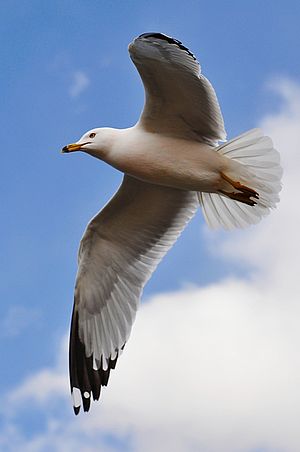Nature Note – Soaring

Staying effortlessly above the water. Image by Jiyang Chen from Wikipedia.
Ever notice the amount of time gulls can spend floating over the lake without flapping their wings? On a windy day, they use up flowing drafts of air caused by waves to stay aloft. Wind is slower near the water surface due to friction and the higher you are above water, so sometimes you will see a bird speed rapidly away as it increases elevation.
Out in the ocean, albatross and other sea birds use a similar mechanism to fly for days using little more energy than what’s needed for resting on land. The birds use prevailing tail winds to gain speed. They then shift into the wind and change the angle of their wings to gain altitude, before again turning to get pushed by the winds. Repeating such dynamic soaring allows the birds to fly miles without ever flapping their wings.
Soaring birds like albatrosses and, less dramatically, gulls have long angular sharp pointed wings. A narrow wing tip reduces the wing area subject to drag-inducing vortex formation. At each wingtip a spiraling vortex forms as air spills from the high-pressure area under the wing into the low-pressure area over it. These long tapered wings are efficient for long flights but the birds are more heavily dependent on wind currents than passive soarers like hawks and turkey vultures.
Passive soarers have broad wings with long primary feathers that spread at the tip. Slots in wing tips lower the air speed atop the wings creating turbulence stalling forward motion. These wings are useful for low-speed maneuvering. Passive soarers take advantage of upward motion of air caused by differences in temperature (thermals) or geographic obstructions like cliffs or mountains. These same thermals keep sail planes and hang-gliders aloft.
Soaring birds have been an inspiration for poets and aviators for centuries. As Helen Keller said, “one can never consent to creep when one feels an impulse to soar.”
